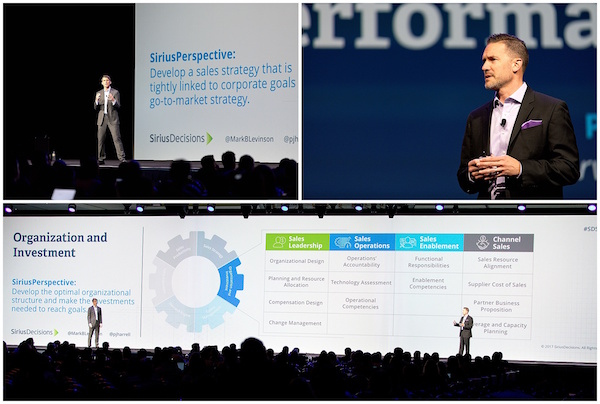Six Components of a Highly Effective Sales Machine
- On the main stage at SiriusDecisions Summit 2017, Mark Levinson and Phil Harrell introduced the Sales Operating Model
- The model has four roles at its core: sales leadership, sales operations, sales enablement and channel sales
- Each role plays a key part in the six standards sales organizations should implement and utilize to drive operational excellence
What if you were offered the opportunity to become the general manager of your favorite sports team? This may be a dream come true for some of us, but we would all need to start our list of things to do upon accepting the job with the same question: What do I need to put in place to ensure my team’s success? Should I focus on recruiting or trading for new players, or change the way I organize and manage them? Do I need to change our strategy for how we play the game? Or is it a combination of all of these factors?

In their keynote session today at Summit 2017 in Las Vegas, Mark Levinson and Phil Harrell addressed a key issue that B2B sales leaders face today: a lack of insight into which standards allow high-performing sales organizations to achieve top results. “As the point person for revenue growth, sales leaders are under constant, tremendous pressure to deliver revenue results against corporate goals,” said Phil. “Today, we’re going to share with you a clear blueprint for architecting a winning sales machine – including the processes, people, strategy and data that should be implemented.”
During their presentation, Mark and Phil introduced the SiriusDecisions Sales Operating Model and the four roles at its core: sales leadership, sales operations, sales enablement and channel sales.
“Sales leadership must sponsor and drive the operating model,” Mark clarified, “while operations puts processes in place, deliver sales intelligence and builds a priority-led technology stack. The sales enablement function drives the talent lifecycle – from onboarding to optimizing and ensuring that the sales strategy components are translated for the field – and channel partners, which are playing a larger role in B2B sales success, must operate consistently.”
The Sales Operating Model has six standards that sales organizations should implement and utilize to drive operational excellence, and each of the four roles plays an important part:
- Sales strategy. Sales leaders need to make sure that they and their peers in the C-suite have jointly developed and are in complete agreement on the go-to-market strategy, starting with a clear identification of the target audience. Sales operations, sales enablement and channel sales focus on aspects of strategy such as account/territory optimization, sales communication and indirect routes to market.
- Organization and investment. Sales leaders at top-performing organizations carefully think through the optimal organizational structure that allows them to efficiently pursue their target market segments, and the right mix of investments between people and enablement capabilities required to win. Sales operations, sales enablement and channel sales focus on aspects such as operational and enablement competencies and coverage and capacity planning.
- Talent management. Sales leaders must create a profile of the ideal salesperson who fits the sales strategy, then put in place a strong recruitment process similar to a pipeline to attract candidates who match that profile. Sales operations, sales enablement and channel sales focus on aspects such as compensation assessment, ongoing learning and development, and partner profiling.
- Demand engine. Sales leaders must develop a plan to optimize various lead sources and demand management processes to efficiently generate the right quality and quantity of opportunities with high-quality leads. Sales operations, sales enablement and channel sales focus on aspects such as demand analysis, sales asset audit and gap analysis, and process management.
- Sales execution. Sales leaders should develop and implement a solid opportunity management process – which includes the sales methodology and buyer-driven sales process – to make sure the sales team is executing consistently and effectively to move opportunities through closure, accompanied by a sales management process that reinforces opportunity management and ensures consistent deal inspection and accurate forecasting. Sales operations, sales enablement and channel sales focus on aspects such as sales metrics and measurement, continuous learning, and partner activation.
- Sales productivity. Finally, sales leaders need to implement a sales productivity measurement standard to continually assess the productivity of the sales team, using a sales activity study to evaluate the amount of time reps are spending on core selling activities vs. peers and completing the SiriusDecisions Sales Productivity Quotient to get a full picture of their sales organization’s productivity. Sales operations, sales enablement and channel sales focus on aspects such as technology optimization, sales asset management and partner assessment.
By using benchmark data to assess their organizations against the model, sales leaders can determine what improvements they should prioritize. The model specifies benchmark metrics to assess for each of its six standards.
“Winning general managers and coaches develop a comprehensive blueprint for success that they implement and adhere to,” Phil stated. “With the Sales Operating Model, sales leaders now have a blueprint for success – a way to define the standards that they’ve implemented to organize their resources and build a scalable sales machine to deliver value to customers.”
For an assessment that aligns to the six standards of the Sales Operating Model and is designed to help sales leaders benchmark their organization against best practices proven to maximize growth, see “The SiriusDecisions Sales Operating Model Assessment.”